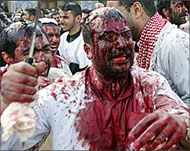Karbala central to Sunni-Shia split
The name of Karbala has haunted the Shia psyche for well over a thousand years.

It was here that the Prophet Muhammad’s grandson, al-Husayn, met his death in 680.
Collective guilt at failing to prevent al-Husayn’s death has led the Shia to the very public demonstrations of self-beating and penance each year.
His death at Karbala highlights one of the greatest schisms in Islamic history.
Historic split
Al-Husayn had claimed the right to rule the Muslim world upon the death of the Umayyad caliph Muawiya.
However, Muawiya’s son Yazid, contested the claim and fighting resulted.
Al-Husayn’s tiny army was surrounded at Karbala on the edge of the desert and he and his troops were massacred.
Najaf connection
About 1300 years later, Karbala’s most famous tomb, with a gilded dome and three minarets, is the central building in the city and a place of pilgrimage for Shia Muslims.
There is also a shrine to his step brother Abbas, who also died in the battle.
Al-
 |
|
Some Shia go to extremes in |
Husayn’s father, Ali bin abi Talib, is buried at Najaf, 190km south of the capital and 80km from Karbala.
One common Iraqi custom during that season is to make a pilgrimage from the Iraqi city of Najaf to Karbala.
Shia schism
Ali married the Prophet Muhammad’s daughter, Fatima, and had been the fourth caliph.
But after his death, the Shia – or partisans of Ali – broke away and have remained distinct to this day.
The cities of Karbala and Najaf have traditionally made their money from the thousands of pilgrims arriving from Iran and India.
Pilgrimage
For Shia Muslims, great spiritual rewards are obtained by visiting the graves of the prophet’s grandson and his relatives.
Some even hold that visiting Karbala relieves the faithful of worldly afflictions and benefits them on the day of judgment.
Hundreds of thousands come from all parts of the world all year round – particularly during the first 10 days of the Islamic month called Muharram and the 20th of Safar.